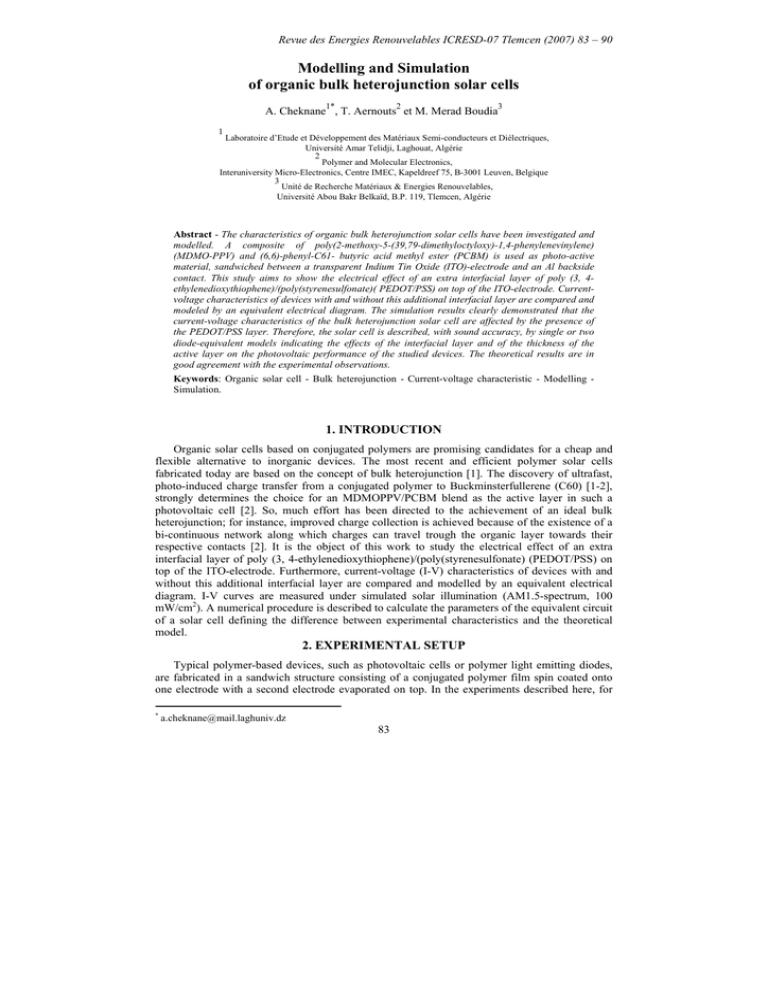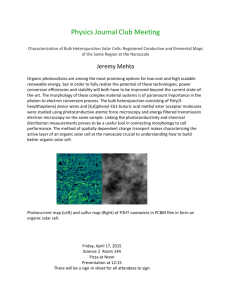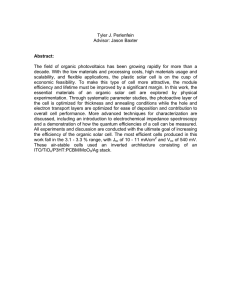Modelling and Simulation of organic bulk heterojunction solar cells
advertisement

Revue des Energies Renouvelables ICRESD-07 Tlemcen (2007) 83 – 90
Modelling and Simulation
of organic bulk heterojunction solar cells
1*
2
3
A. Cheknane , T. Aernouts et M. Merad Boudia
1
Laboratoire d’Etude et Développement des Matériaux Semi-conducteurs et Diélectriques,
Université Amar Telidji, Laghouat, Algérie
2
Polymer and Molecular Electronics,
Interuniversity Micro-Electronics, Centre IMEC, Kapeldreef 75, B-3001 Leuven, Belgique
3
Unité de Recherche Matériaux & Energies Renouvelables,
Université Abou Bakr Belkaïd, B.P. 119, Tlemcen, Algérie
Abstract - The characteristics of organic bulk heterojunction solar cells have been investigated and
modelled. A composite of poly(2-methoxy-5-(39,79-dimethyloctyloxy)-1,4-phenylenevinylene)
(MDMO-PPV) and (6,6)-phenyl-C61- butyric acid methyl ester (PCBM) is used as photo-active
material, sandwiched between a transparent Indium Tin Oxide (ITO)-electrode and an Al backside
contact. This study aims to show the electrical effect of an extra interfacial layer of poly (3, 4ethylenedioxythiophene)/(poly(styrenesulfonate)( PEDOT/PSS) on top of the ITO-electrode. Currentvoltage characteristics of devices with and without this additional interfacial layer are compared and
modeled by an equivalent electrical diagram. The simulation results clearly demonstrated that the
current-voltage characteristics of the bulk heterojunction solar cell are affected by the presence of
the PEDOT/PSS layer. Therefore, the solar cell is described, with sound accuracy, by single or two
diode-equivalent models indicating the effects of the interfacial layer and of the thickness of the
active layer on the photovoltaic performance of the studied devices. The theoretical results are in
good agreement with the experimental observations.
Keywords: Organic solar cell - Bulk heterojunction - Current-voltage characteristic - Modelling Simulation.
1. INTRODUCTION
Organic solar cells based on conjugated polymers are promising candidates for a cheap and
flexible alternative to inorganic devices. The most recent and efficient polymer solar cells
fabricated today are based on the concept of bulk heterojunction [1]. The discovery of ultrafast,
photo-induced charge transfer from a conjugated polymer to Buckminsterfullerene (C60) [1-2],
strongly determines the choice for an MDMOPPV/PCBM blend as the active layer in such a
photovoltaic cell [2]. So, much effort has been directed to the achievement of an ideal bulk
heterojunction; for instance, improved charge collection is achieved because of the existence of a
bi-continuous network along which charges can travel trough the organic layer towards their
respective contacts [2]. It is the object of this work to study the electrical effect of an extra
interfacial layer of poly (3, 4-ethylenedioxythiophene)/(poly(styrenesulfonate) (PEDOT/PSS) on
top of the ITO-electrode. Furthermore, current-voltage (I-V) characteristics of devices with and
without this additional interfacial layer are compared and modelled by an equivalent electrical
diagram. I-V curves are measured under simulated solar illumination (AM1.5-spectrum, 100
mW/cm2). A numerical procedure is described to calculate the parameters of the equivalent circuit
of a solar cell defining the difference between experimental characteristics and the theoretical
model.
2. EXPERIMENTAL SETUP
Typical polymer-based devices, such as photovoltaic cells or polymer light emitting diodes,
are fabricated in a sandwich structure consisting of a conjugated polymer film spin coated onto
one electrode with a second electrode evaporated on top. In the experiments described here, for
*
a.cheknane@mail.laghuniv.dz
83
84
A. Cheknane et al.
the standard devices, (Fig. 1) blends of MDMO-PPV: PCBM (1:4wyw) were spin coated from a
chlorobenzenesolution w7x onto ITO coated glass. Afterwards, an Al-electrode was evaporated
on top through a shadow mask, resulting in cells with an active area of 0.02 cm2. Keeping the
devices in an inert nitrogen atmosphere, JV-characteristics were obtained with an HP4145B
semiconductor parameter analyser. Under these circumstances illumination could only be
provided by a halogen lamp. Some devices were taken out of the nitrogen box to measure them
under simulated solar illumination (AM1.5-spectrum, 100 mW/cm2). Devices with an extra 140nm thick PEDOT/PSS layer, spin-coated on top of ITO before depositing the active layer, were
also fabricated. Thickness variations of the active layer were established by applying different
spin speeds during the deposition of the organic blend for different cells. Measuring the thickness
of the active layer was done as a final step using a Dektak profilometer.
Fig. 1: Bulk donor-acceptor heterojunction solar cell, also with
the chemical structure of the different organic materials used, [2]
3. THEORY
A major difference between inorganic and organic semiconductors is the exciton binding
energy [3]. It is smaller for Si ( ∆ ≅ 25 meV , 2.41kJ/mol) than for organic counterparts
( ∆ = 300 meV , 28.95 kJ/mol). Therefore, the exciton is more stable in organics, than in
inorganics. Organic solar cell efficiency, η , is typically influenced by the following parameters
[4]:
a) photon absorption ηA , b) generation of excitons, c) exciton diffusion ηdiff , d) Holeelectron separation (exciton dissociation) ηTC , e) Carrier transport towards the electrodes η tr ,
f) Charge collection at respective electrodes.
4. MODELING AND SIMULATION
In the literature one can find different equivalent circuits used in modelling an organic solar
cell. Through this section, we review the most important models.
4.1 Three-diode model
B. Mazhari [5] proposed a solar cell model for organic solar cells, as shown in figure 2. R int
sh
represents loss due to polaron recombination and R int
s models charge extraction to the electrodes.
Diodes D1 and D 2 are ideal diodes that represent short circuit under forward bias and open
circuit under reverse bias, respectively.
4.2 Single-diode model
Under illumination, the cell may be represented by an equivalent circuit, based on a singlediode model, as shown in Figure 3. It is described as a current source in parallel with the junction
as shown in equation (1):
ICRESD’2007: Modelling and simulation of organic bulk heterojunction solar cells
85
Fig. 2: A simplified equivalent circuit two diode model for
organic solar cells in which losses are modelled in terms of resistances
Fig. 3: Equivalent scheme of a real PV cell under
illumination, based on a single-diode model
e
R
V
( V − I R s ) − 1
+ I L = I s exp
I 1 + s −
(1)
n
k
T
R
R
sh
sh
Where I L originates from the charge generated by illumination; I s is the saturation current
under reverse bias; R L is the external circuit resistance; R s and R sh are respectively series
resistance and shunt resistance; n n is the ideality factor.
Series resistance of a given PV solar cell depends on resistivities of the semiconductor bulk,
the metal electrodes, and the metal/semiconductor interface. Similarly, in an organic solar cell, the
series resistance depends on the resistivities of the organic material(s), the metal electrodes and
the metal/organic interface [6]. The series and shunt resistances are linked as shown in equation
(2):
I R
I sc = I L − sc s
(2)
R sh
In order to modelize an organic solar cell, Jain and Kapoor [7] presented a new single-diode
based approach using Lambert W-function. The model is shown in Figure 4.
Fig. 4: Equivalent circuit for an organic solar cell (Lambert W-function approach)
4.3 Two-diode model
The new simplified equivalent circuit, of a two diode model solar cell, may be described by
the lumped parameter equivalent circuit of Figure 5 [8-9].
86
A. Cheknane et al.
Fig. 5: Equivalent circuit of a two-diode model solar cell
For a given incident light intensity, at a given temperature, the implicit I − V relationship is
shown in equation (3):
I = I ph −
V + I.R s
− I 01 [ exp { B1 ( V + I . R s
R sh
)} − 1 ] − I 02 [ exp { B2 ( V + I . R s )} − 1 ]
(3)
Where B1 = q k T and B 2 = B1 n
I ph is the photocurrent; q is the electronic charge; k is Boltzmann’s constant, T is the
temperature; R s is the series resistance; R sh is the shunt resistance and n is the diode ideality
factor; I 01 represents the electronic conduction phenomena in the quasi neutral region of the
junction, such as diffusion, recombination and the drift effect [8]; I 02 corresponds to the carrier
recombination via deep levels in the space-charge region of the junction [10]. The reverse
saturation current I 02 is generally 3 to 7 orders of magnitude larger than I 01 ; the diode quality
factor n equals 2 for the approximation corresponding to the Shockley-Read-Hall recombination
current in the space-charge region [8, 11]; n is also a fit parameter that is more than 2.
The experimental study of the temperature dependence of the two terms should help to verify
their different origins. Such studies have been published under dark conditions [8, 12].
It is of great interest to determine the temperature dependence of parameters I 01 and I 02
while the cell is operating as a generator under illumination. It should be noted that: the
illumination does not cause a simple translation of current-voltage characteristic along the current
axis [8, 13], the series resistance effect is non linear and the injection level goes from a low to a
high level.
Differentiation of equation (3) while considering of the values:
dV
(4)
R sh 0 = −
d l I = I
sc
And
dV
R s 0 = −
d l V = V0C
(5)
Then
R sh =
1
1
− B1 . I 01 . exp ( B1 . I sc . R s ) − B 2 . I 02 . exp ( B 2 . I sc . R s
R sh 0 − R s
)
(6)
And
R s = R s0 −
1
1
+ B1 . I 01 . exp ( B1 . Voc ) + B 2 . I 02 . exp ( B 2 . Voc
R sh
)
(7)
R s 0 and R sh 0 are the experimental values of the dynamic resistance which express the
behaviour of the I − V curve around the open-circuit voltage and around the short-circuit points.
For V = Voc and I = I sc , we deduce from equation (3) that:
ICRESD’2007: Modelling and simulation of organic bulk heterojunction solar cells
I ph =
Voc
+ I 01 .[ exp ( B1 . Voc ) − 1] + I 02 .[ exp ( B 2 . Voc ) − 1 ]
R sh
Voc −
I 02 =
( R s + R sh ). Isc
− I 01 .[ exp ( B1 . I sc . R s ) − exp ( B1 . Voc
R sh
exp ( B 2 . I sc . R s ) − exp ( B 2 . Voc )
87
(8)
)]
(9)
The value of the saturation current I 01 is found to be the root of the equation G ( I 01 ) = 0 ,
with:
G ( I 01 ) = I ( M . P.) − I mp
(10)
Where Imp is the experimental value and I ( M. P ) is the value calculated from equation (3)
for maximum power. The basic flow of the program needed to resolve the double exponential
equation is outlined in Figure 6.
Fig. 6: Flow chart of the program for the resolution, of the double exponential equation (n = 2)
5. RESULTS AND DISCUSSION
The simulated J − V plots, together with experimental counterparts, are represented in
Figures 7-14 with or without an extra interfacial layer of poly (3, 4ethylenedioxythiophene)/poly(styrenesulfonate) (PEDOT/PSS) on top of the ITO-electrode. The
current-voltage characteristics of devices with and without this additional interfacial layer are
compared and modelled by an equivalent electrical diagram. The plotted curves show that the
single-diode model provides a very precise description of the J − V characteristics of the device
with additional interfacial layer with different active layer thicknesses: 140 nm, 190 nm, 210 nm
and 420 nm.
However, the characteristics J − V curves, for standard cell without an interfacial
PEDOT/PSS layer with active layer thicknesses: 210 nm, 220 nm, 310 nm, and 370 nm, show
clearly that the tested solar cells can be described with the two diode equivalent model.
88
A. Cheknane et al.
Fig. 7: Characteristics JV- curves for standard
cell without an interfacial PEDOT/PSS layer.
The active layer thickness = 370 nm
Fig. 8: Characteristics JV- curves for standard
cell without an interfacial PEDOT/PSS layer.
The active layer thickness = 310 nm
Fig. 9: Characteristics JV- curves for standard
cell without an interfacial PEDOT/PSS layer.
The active layer thickness = 220 nm
Fig. 10: Characteristics JV- curves for
standard cell without an interfacial
PEDOT/PSS layer. The active layer
thickness=210 nm
Fig. 11: Characteristics JV- curves for
standard cell with an interfacial PEDOT/PSS
layer. The active layer thickness = 420 nm
Fig. 12: Characteristics JV- curves for
standard cell with an interfacial PEDOT/ PSS
layer. The active layer thickness = 210 nm
ICRESD’2007: Modelling and simulation of organic bulk heterojunction solar cells
Fig. 13: Characteristics JV- curves for
standard cell with an interfacial PEDOT/PSS
layer. The active layer thickness = 190 nm
89
Fig. 14: Characteristics JV- curves for
standard cell with an interfacial PEDOT/PSS
layer. The active layer thickness = 140 nm
6. CONCLUSION
In summary, the simulation illustrates clearly that the extra interfacial layer of poly
(3,4ethylenedioxythiophene)/(poly(styrenesulfonate) (PEDOT/PSS) on top of the ITO-electrode
of organic bulk heterojunction solar cells affects strongly the electrical characteristics of the
device. We have shown that the studied device can be described by single or two equivalent
models demonstrating the effects of the interfacial layer and of the thickness of the active layer on
the photovoltaic performance. A methodology for extracting electrical parameters, for both
models, has been outlined and illustrated trough simulation results.
From the results reported here, it is clear that the single-diode model provides a very precise
description of the J-V characteristics of the device with additional interfacial layer; whereas the
estimated parameters proved that the two-diode equivalent model described consistently the tested
solar cells without additional interfacial layer.
REFERENCES
[1] J.L. Segura, F. Giacalone, R. Gomez, N. Martin, D.M. Guldi, C. Luo, A. Swartz, I. Riedel, D. Chirvase, J.
Parisi, V. Dyakonov, N. Serdar Sariciftci and F. Padinger, ‘Design, Synthesis and Photovoltaic Properties
of [60] Fullerene Based Molecular Materials’, Materials Sciences and Engineering, Vol. C 25, pp. 835 842, 2005.
[2] T. Aernouts, W. Geens, J. Poortmans, P. Heremans, S. Borghs and R. Mertens, ‘Extraction of Bulk and
Contact Components of the Series Resistances in Organic Bulk Donor-Acceptor Heterojunctions’, Thin
Solid Films Vol. 403/404, pp. 297 - 301, 2002.
[3] M. Burgelman and B. Minnaert, ‘Including Excitons in Semiconductor Solar Cell Modelling’, Thin Solid
Films, Vol. 511/512, pp. 214 – 218, 2006.
[4] A. Moliton and J.M. Nunzi, ‘How to Model the Behaviour of Organic Photovoltaic Cells’, Polym Int.,
Vol. 55, pp. 583 – 600, 2006.
[5] B. Mazhari, ‘An Improved Solar Cell Circuit Organic Solar Cells’, Solar Energy Materials & Solar Cells,
Vol. 90, pp. 1021 – 1033, 2006.
[6] J.M. Nunzi, ‘Organic Materials and Devices for Photovoltaic Applications’, ERT Cellules Solaires
Photovoltaïques Plastiques, Labo POMA, Angers, France, pp. 197 – 224, 2002.
[7] A. Jain and A. Kapoor, ‘A New Approach to Study Organic Solar Cell Using Lambert W-Function’, Solar
Energy Materials & Solar Cells, Vol. 86, pp. 197 – 205, 2005.
90
A. Cheknane et al.
[8] J.P. Charles, ‘Caractérisation I-V et Fonctionnement des Photopiles Solaires’, Thèse de Doctorat ès
Sciences, Université des Sciences et Techniques du Languedoc, Juillet 1984.
[9] G.L. Araujo, E. Sanchez and M. Marti, ‘Determination of the Two-Exponential Solar Cell Equation
Parameters from Empirical Data’, Solar Cells, Vol. 5, pp. 199 – 204, 1982.
[10] C.J. Brabec, J.A. Hauch, P. Schilinsky and C. Waldauf, ‘Theme Article – Production Aspects of Organic
Photovoltaics and Their Impact on the Commercialization of Devices’, Mrs Bull., Vol. 30, p. 50, 2005.
[11] J.P. Charles, A. Haddi, A. Maouad, H. Bakhtiar, A. Zerga, A. Hoffmann and P. Mialhe, ‘La Jonction, du
Solaire à la Microélectronique’, Rev. Energ. Ren., Vol. 3, pp. 1 – 16, 2000.
[12] M. Wolf, G.T. Noel and R.J. Stirn, IEEE Trans. on Electron Dev., ED-24, Vol. 4, pp. 419 – 428, 1977.
[13] R.N. Hall, ‘Silicon Photovoltaic Cells’, Solid - State Electron., Vol. 24, pp. 595 – 616, 1981.

